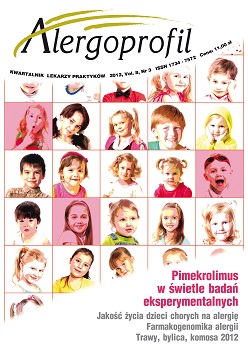Pimecrolimus in experimental studies
Main Article Content
Abstract
Pimecrolimus (PIM) is a calcineurin inhibitor used as topical anti-inflammatory and immunomodulatory drug. PIM inhibits the synthesis and release of cytokines by T cells, and activation and release of inflammatory mediators by mast cells and neutrophils. It is registered in a form of 1% cream for the treatment of mild and moderate atopic dermatitis in patients aged 2 years and older. In the topical treatment of inflammatory skin diseases of different extension and intensity of skin lesions pharmacokinetic properties of topical used drug are relevant because of the possibility of it’s side effects. We present results of several experimental studies performed in vivo and in vitro to evaluate distribution, permeation and metabolism of pimecrolimus in the skin and it’s elimination from the body.
Downloads
Article Details
Copyright: © Medical Education sp. z o.o. This is an Open Access article distributed under the terms of the Attribution-NonCommercial 4.0 International (CC BY-NC 4.0). License (https://creativecommons.org/licenses/by-nc/4.0/), allowing third parties to copy and redistribute the material in any medium or format and to remix, transform, and build upon the material, provided the original work is properly cited and states its license.
Address reprint requests to: Medical Education, Marcin Kuźma (marcin.kuzma@mededu.pl)
References
2. Grassberger M., Steinhoff M., Schneider D. et al.: Pimecrolimus – an anti-inflammatory drug targeting the skin. Exp. Dermatol. 2004 Dec, 13(12): 721-30.
3. Büchau A.S., Schauber J., Hultsch T. et al.: Pimecrolimus enhances TLR2/6-induced expression of antimicrobial peptides in keratinocytes. J. Invest. Dermatol. 2008 Nov, 128(11): 2646-54.
4. Spergel J.M.: Pimecrolimus cream in the management of patients with atopic eczema. Clin. Cosmet. Investig. Dermatol. 2009 May, 19(2): 85-93.
5. Spergel J.M.: Immunology and treatment of atopic dermatitis. Am. J. Clin. Dermatol. 2008, 9(4): 233-44.
6. Gschwind H.P., Waldmeier F., Zollinger M. et al.: Pimecrolimus: skin disposition after topical administration in minipigs in vivo and in human skin in vitro. Eur. J. Pharm. Sci. 2008 Jan, 33(1): 9-19.
7. Meurer M., Lubbe J., Kapp A. et al.: The role of pimecrolimus cream 1% (Elidel) in managing adult atopic eczema. Dermatology 2007, 215 (suppl. 1): 18-26.
8. Allen B.R., Lakhanpaul M., Morris A. et al.: Systemic exposure, tolerability, and efficacy of pimecrolimus cream 1% in atopic dermatitis patients. Arch. Dis. Child. 2003 Nov, 88(11): 969-73.
9. Zollinger M., Waldmeier F., Hartmann S. et al.: Pimecrolimus: absorption, distribution, metabolism, and excretion in healthy volunteers after a single oral dose and supplementary investigations in vitro. Drug Metab. Dispos. 2006 May, 34(5): 765-74.
10. Kapp A., Papp K., Bingham A. et al.: Long-term management of atopic dermatitis in infants with topical pimecrolimus, a nonsteroid anti-inflammatory drug. J. Allergy Clin. Immunol. 2002 Aug, 110(2): 277-84.
11. Billich A., Aschauer H., Aszódi A. et al.: Percutaneous absorption of drugs used in atopic eczema: pimecrolimus permeates less through skin than corticosteroids and tacrolimus. Int. J. Pharm. 2004 Jan 9, 269(1): 29-35.
12. Bavandi A., Fahrngruber H., Aschauer H. et al.: Pimecrolimus and tacrolimus differ in their inhibition of lymphocyte activation during the sensitization phase of contact hypersensitivity. J. Dermatol. Sci. 2006 Aug, 43(2): 117-26.
13. Weiss H.M., Fresneau M., Moenius T. et al.: Binding of pimecrolimus and tacrolimus to skin and plasma proteins: implications for systemic exposure after topical application. Drug Metab. Dispos. 2008 Sep, 36(9): 1812-8.
14. Zahir H., Nand R.A., Brown K.F. et al.: Validation of methods to study the distribution and protein binding of tacrolimus in human blood. J. Pharmacol. Toxicol. Methods 2001 Jul-Aug, 46(1): 27-35.
15. Zahir H., McCaughan G., Gleeson M. et al.: Factors affecting variability in distribution of tacrolimus in liver transplant recipients. Br. J. Clin. Pharmacol. 2004 Mar, 57(3): 298-309.
16. Venkataramanan R., Swaminathan A., Prasad T. et al.: Clinical pharmacokinetics of tacrolimus. Clin. Pharmacokinet. 1995 Dec, 29(6): 404-30.
17. Eichenfield L.F., Beck L.: Elidel (pimecrolimus) cream 1%: a nonsteroidal topical agent for the treatment of atopic dermatitis. J. Allergy Clin. Immunol. 2003 May, 111(5): 1153-68.
18. Lakhanpaul M., Davies T., Allen B.R. et al.: Low systemic exposure in infants with atopic dermatitis in a 1-year pharmacokinetic study with pimecrolimus cream 1%. Exp. Dermatol. 2006 Feb, 15(2): 138-41.
19. Thaçi D., Salgo R.: The topical calcineurin inhibitor pimecrolimus in atopic dermatitis: a safety update. Acta Dermatoven. APA 2007, 16(2): 58-62.
20. Hagstroemer L., Ye W., Nyren O. et al.: Incidence of cancer among patients with atopic dermatitis. Arch. Dermatol. 2005, 141(9): 1123-7.
21. Wang H., Diepgen T.L.: Atopic dermatitis and cancer risk. Br. J. Dermatol. 2006, 154(2): 205-10.

